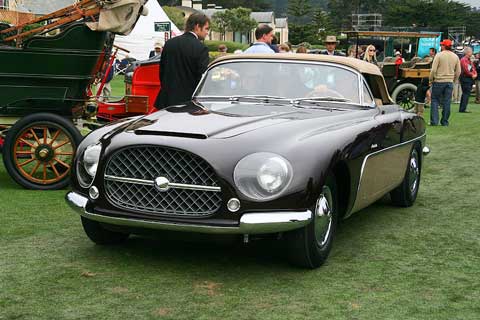
Photo by Hugues Vanhoolandt.
By Brandes Elitch
As recounted in a previous article, the organizers of the Pebble Beach concours, in an effort to dispel the image of the entrants as so called trailer queens, initiated a drive for the entrants around the Monterey Peninsula.
In the event of a tie in class, the car that has completed the drive gets the nod in the judging. As part of this procession, the cars are parked in downtown Carmel for a few hours in the middle of the day, and in the middle of the street, for everyone to see. As I was threading my way through them, I saw something I had never seen before. It was obviously an early fifties car, obviously Italian, and the script said “Cisitalia.” I approached the owner, Urs Jakob, and said, “I’ve never seen a Cisitalia this big before. He replied, “This isn’t a Cisitalia; it’s a Ford!” Boy, was that a shock.
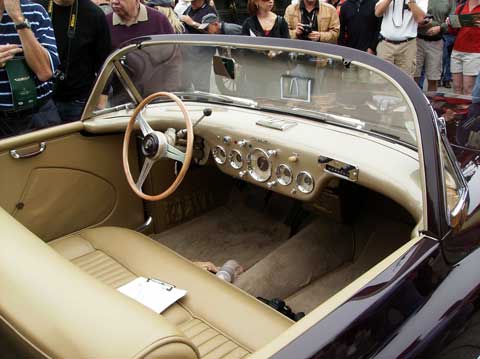 Interior is similar to the early Corvettes. Photo by Brandes Elitch.
Interior is similar to the early Corvettes. Photo by Brandes Elitch.
He went on to explain that in the early 1950’s, Ford was considering the idea of what we now call a personal luxury car, which later became, of course, the two-seater Thunderbird. Keep in mind that, unlike GM and Chrysler, up until then, Ford did not really have any dream cars except the three cars made for Edsel Ford for his own personal use, which were never displayed for the public to see. In the early 1950s, Ford commissioned the building of six prototypes: two were bodied by Ghia, and four by Vignale, including Mr. Jakob’s car. Ford shipped 6 stock Ford chassis to Vignale; this particular car had a straight six, some of the others had the V-8. The current owner told me that he owns two of the cars, and he is hot on the trail of a third.
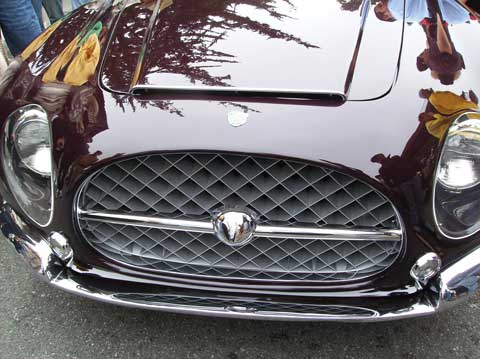 Photo by Brandes Elitch.
Photo by Brandes Elitch.
This car, called 808XF, was really a product of Henry Ford II’s vision. HFII is vastly underestimated as a titan of Detroit. If you are not familiar with his career, you might want to read ” The Fords, An American Epic,” by Peter Collier and David Horowitz, 1987, Summit Books, NY, NY. This is the definitive biography of HFII. To quote from the book, (p. 438), “The general view of Henry II was that he was a boorish oaf, the inheritor who might have saved the company in his youth, but had long since become the consummate vulgarian and corporate figurehead. On the contrary, we discovered a shrewd and vigorous man who was, in the context of his times, equal to his grandfather, a colossus who had dominated American business from the time he left the Navy as a green twenty-four year old until his recent retirement.” In short, HFII saved the company from bankruptcy by firing Harry Bennett and hiring the famous Whiz Kids and then spent the next 30 years keeping a firm hand on the wheel. He also inherited from his father (Edsel Ford) an interest in styling. He owned a Cisitalia (remember that the Museum of Modern Art had chosen it as one of the ten most beautiful cars in the world), and in 1951 he personally went to Europe and inked an agreement with Cisitalia to build cars together. Originally, the idea was to use a chassis designed by Giovanni Savonuzzi, which is interesting because today we associate Savonuzzi with styling, not engineering. The first two cars were built in 1952. In 1953, Ford agreed to finance four more prototypes, and in 1953 Vignale built a coupe and convertible. But Mr. Jakob explained to me that the car was really a prototype and unsuited to high volume production. For instance, the gas filler pipe was in the trunk, and it didn’t have roll-up windows! Of course, Vignale built cars by hand, and so what we today call fit and finish was hopeless, since one person built the left side and another built the right side, and most of the time they were not an exact match! Now Ford could have rectified this if they went in to large scale production (as they did with the Thunderbird), but with the passing of fifty years, it is clear that the lines of the 1955 Thunderbird were a lot closer to American expectations than those of the Vignale convertible.
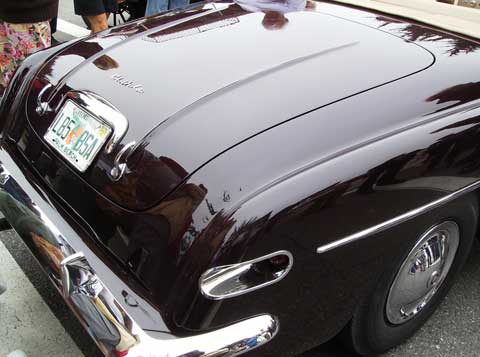 Photo by Brandes Elitch.
Photo by Brandes Elitch.
Vignale is an interesting story too. Alfredo Vignale (1913-1969) started out by working for Stablimenti Farina (older brother of Pinin Farina) in the 1930s, and in 1948 built a body on a Fiat Topolino chassis. This was so successful that he spent the next 20 years designing and building small-batch custom bodies for all of the Italian manufacturers, including about 140 early Ferraris. Vignale designed cars for over thirty manufacturers, including our own Briggs Cunningham. But by 1969 the economics for this sort of production changed, and the company was sold to De Tomaso, who needed the plant to produce the Pantera.
Sadly, Vignale was killed in a car crash (driving a Maserati?) three days after the sale was consummated. Vignale was taken over by Ghia (also a Ford subsidiary) in 1969, and ceased to exist in 1974, except as a Ford trademark. Many of the early Vignale designs were penned by Giovanni Michelotti (1921-1980), who designed over 1200 models in the course of his career. Indeed, at the 1954 Torino Motor Show, forty of the new designs were from his hand. So, it is very likely that Michelotti had some influence on the styling of the prototypes for the Ford-Cisitalia.
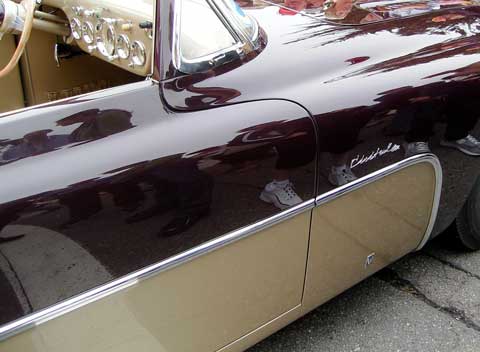 Photo by Brandes Elitch.
Photo by Brandes Elitch.
But, in 1953, General Motors unveiled the Corvette, and this lit a fire at Ford, leading to the realization that they needed to gear up for high volume (15,000 cars a year, compared to Vignale’s capability of perhaps 5% of that!). So, the 6 prototypes remained just that – prototypes. Ultimately, there were a variety of other Ford European joint ventures: the Cobra, the Pantera, the GT 40, the Sunbeam Tiger, etc. The Ford-Cisitalia is not really an example of what might have been — it was too far off the mark for that. But it is one-of-a-kind: a personal commission by Ford’s Chairman of the Board to design and build a beautiful car, something quite different from what was available from the Ford styling studios at the time.
Some time back, early 1970’s, I ran across another of the Cisitalia/Fords. Unfortunately, when the mechanic started the motor he caught his hand in the fan blade and was cut badly. In the ensueing mayham, I left and forgot where the car was. My memory is that it was a coupe and was located in Westchedter, N Y
from what I know Vignale was killed in one of his last models either the Fiat 124 Eveline [of which I have one]or the Fiat 125 Samanter
intresting indeed how american taste has changed.while the 55-57 tbird was a great looking design the new recent one has just as much relation to the lines of the vignale.
Another great story, all new information to me. But didn’t Oliver Kuttner have a car of pretty much the same description and history at his shop near Charlotteville about 10-15 years ago? I think I have picture of it here somewhere, and the styling had some major differences.
And it’s a shame that Vignale and that sort of business has passed, I was lucky enough to own one of his works, a Vignale Italia, now beautifully restored in Austria.
Doug Chadwick
Surely it is not quite correct to state: “Alfredo Vignale (1913-1969) started out by working for Stablimenti Farina (older brother of Pinin Farina).” Surely the older brother was Giovanni, whose body workshops were known as ‘Stabilimenti Industriali Farina’?
Lovely car, nice and rounding like a slightly pudge but cute sophomore highschool girl. Vignale must’ve had a cratefull of those taillights; they’re like the ones on the Ferrari that are the same as the ones on the Ferrari, etc.
alfredo vignale ha cominciato a lavorare a soli undici anni alla de gregori, a 17 anni passo come battilastra alla pinin farina, e divento poi capo reparto agli stabilimenti farina, la sua carriera come carrozziere inizia nel 1946 , con i fratelli guglielmo e giuseppe, e come socio angelo balma.
da notare alcuni elementi ,classici vignale, come i fari posteriori adottate in alcune ferrari su disegno michelotti
Lorenzo Marchesini has provided the following translation to Davide Palombo’s OCT 16th post:
“Alfredo Vignale starts working at the age of only
11 (eleven) at the De Gregori, and at 17 het starts working as a
pannel beater at Pinin Farina (most likely Farina Stabilimenti, LM),
where he became department head at stabilimenti Farina. His career as
an independent coach builder takes of in 1946, together with his
brothers Guglielmo (William/Bill) and Giuseppe (Joe), and his partner
Angelo Balma.”
There’s a great feature on this car in the September issue of Car Collector
Cheers!
Paul
Automobiliart.com
Like the Ford history but want to hear how the car was rediscovered, and when and what was paid for it in rough condition if it ever was rough.